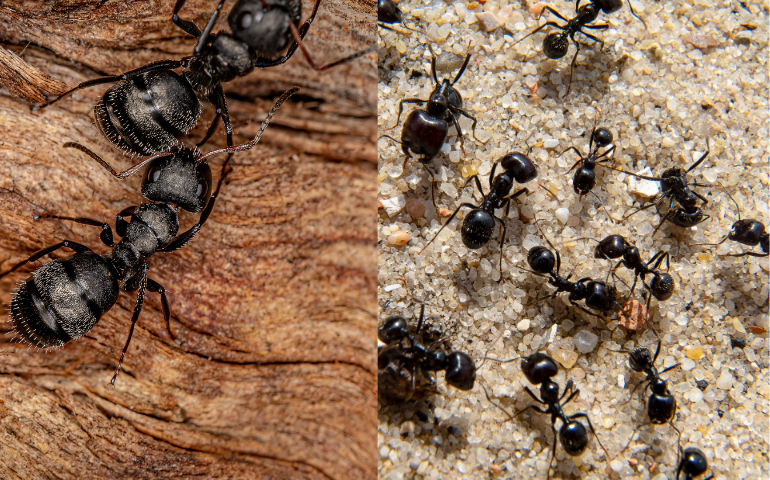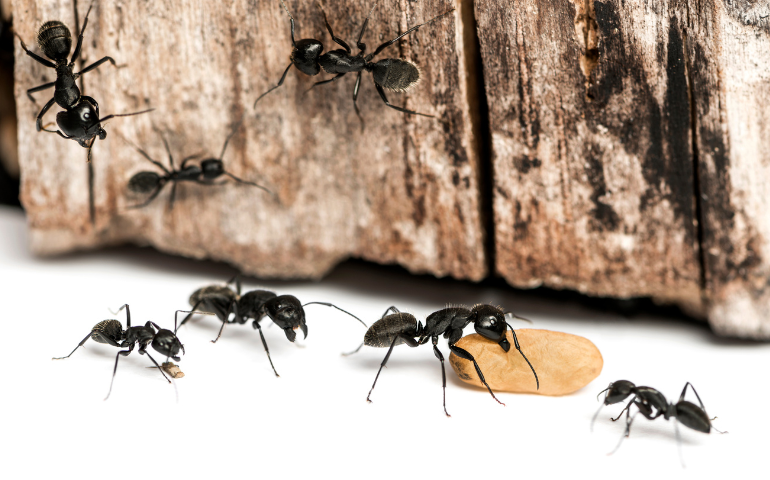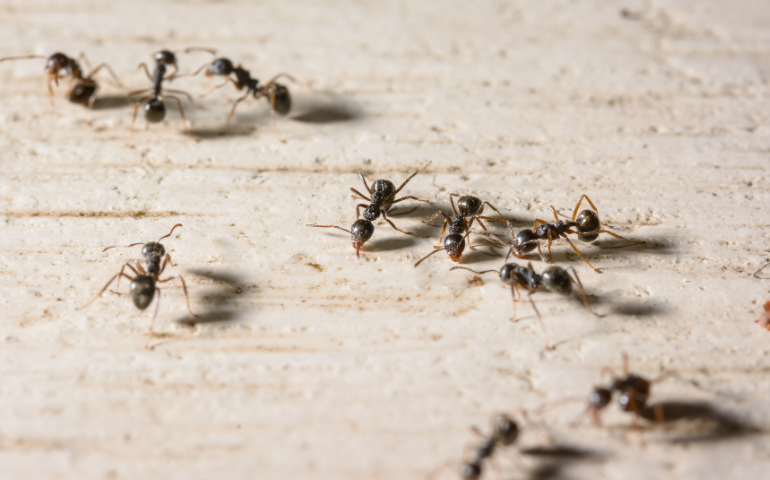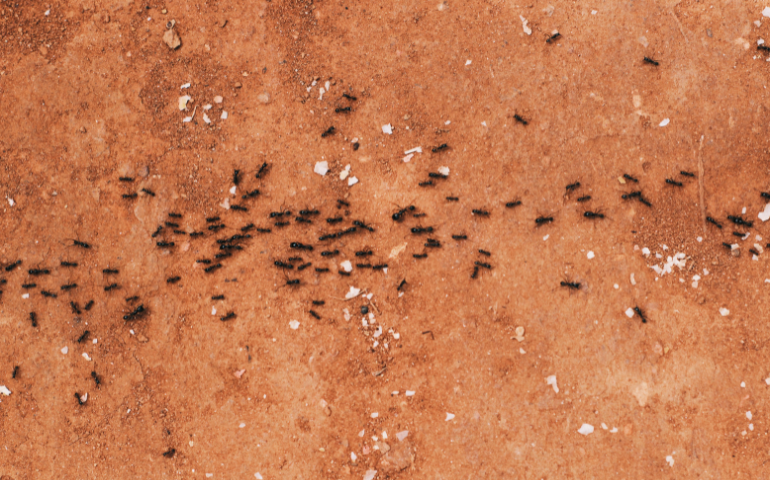The Difference Between Carpenter Ants and Black Ants
Spotting ants in your home can be concerning, but not all ants pose the same threat. Carpenter ants and black ants are commonly confused due to their similar appearance, yet they have distinct characteristics and behaviors that set them apart.
Carpenter ants are typically larger (¼ to ½ inch) and can cause structural damage by hollowing out wood for nesting, particularly in damp areas like basements and attics. They don’t eat the wood but excavate it to create tunnels and galleries. Black ants, in contrast, are smaller (1/16 to 1/8 inch) and prefer nesting in soil or wall voids. While they don’t damage structures, they’re notorious for contaminating food sources, especially those high in sugar or grease. Understanding these differences is crucial for effective pest management.

Key Takeaways
- Carpenter ants (¼-½ inch) hollow out wood for nesting causing structural damage, while black ants (1/16-⅛ inch) are smaller and don’t damage structures but contaminate food sources
- Physical identification: carpenter ants have a one-node waist with varied coloration, while black ants have a uniformly black exterior with a two-node waist structure
- Carpenter ants prefer moist wood and are active at night, creating sawdust-like frass, while black ants establish visible daytime trails between food sources and nests
- Signs of carpenter ant infestations include frass piles and hollow-sounding wood, whereas black ant infestations show visible trails and food contamination
- Professional pest control is recommended for persistent infestations, structural damage concerns, large colonies, or when preventative measures are needed
Identifying Carpenter Ants vs Black Ants
Distinguishing between carpenter ants and black ants requires attention to specific physical traits. These distinguishing characteristics help determine the appropriate treatment method if an infestation occurs, as carpenter ants require different control approaches than black ants.
Physical Characteristics and Appearance
Carpenter ants and black ants have distinct physical differences that make identification possible even to the untrained eye. Carpenter ants are slender with a three-part segmentation (head, thorax, and abdomen) and feature a notably narrow waist with a single-node petiole—the small, raised segment connecting the thorax to the abdomen. Their coloration varies significantly, appearing in black, brown, red, or combinations of these colors.
Black ants, in contrast, have a uniformly black, shiny exterior with an evenly rounded thorax and a two-node petiole, giving their waist a more segmented appearance. The antennal structure also differs between the species, with carpenter ants having bent antennae characteristic of the Formicidae family.
Size Differences
The size disparity between these ant species provides the most immediate visual identification clue. Carpenter ants measure considerably larger, ranging from ¼ to ½ inch in length, making them among the largest ant species in the United States. Black ants are noticeably smaller, typically measuring approximately ⅛ inch in length. This size difference is particularly evident when observing ant trails or groups, where carpenter ants stand out due to their robust bodies compared to the more diminutive black ants. When observed side by side, the size variance becomes immediately apparent and serves as a reliable identification method.
Habitat and Nesting Preferences
Carpenter ants and black ants establish nests in distinctly different environments, which directly impacts how infestations develop and spread. Understanding these habitat preferences helps in effective identification and targeted treatment approaches.
Where Carpenter Ants Live
Carpenter ants establish colonies primarily in moist and decaying wood. These pests create intricate tunnel systems by excavating galleries in wooden structures, leaving behind a sawdust-like material called frass. They don’t actually consume the wood—they simply hollow it out for nesting purposes.

Outdoors, carpenter ants commonly nest in:
- Hardwood trees with existing tree holes
- Rotting stumps and logs
- Wooden fence posts
- Landscaping timbers
- Dead tree branches
In homes and buildings, carpenter ants target:
- Wall voids with moisture issues
- Roof beams and rafters
- Window and door frames
- Floor joists and sub-flooring
- Insulation materials
Unlike termites, carpenter ants maintain a primary nest (with the queen and young) and often establish satellite colonies up to 300 feet away from the main nest. These satellites make detection challenging as they can exist without direct connection to the primary colony. Carpenter ants are most active from dusk until dawn, which further complicates visual identification.
Where Black Ants Live
Black ants establish more visible colonies and don’t cause structural damage to wood. These smaller ants build nests in various locations based on food proximity and environmental conditions.

Outdoor nesting sites for black ants include:
- Small soil mounds in lawns
- Under stones and landscape features
- Beneath debris and leaf litter
- Inside decaying trees (without hollowing them)
- Garden beds and planters
Indoor nesting locations for black ants feature:
- Wall voids and tiny crevices
- Beneath carpeting
- Behind baseboards
- Inside cabinets near food sources
- Window sills with access to the outdoors
Black ants form noticeable trailing patterns between their nests and food sources, unlike the more solitary foraging behavior of carpenter ants. They create consistent pathways that can be traced back to their colonies, making them easier to track. Black ant colonies range from 2,000 to 3,000 workers, with multiple queens possible in established nests.
Behavioral Differences
Carpenter ants and black ants exhibit distinct behavioral patterns that help in their identification. Understanding these differences is crucial for effective pest management and control strategies.
Feeding Habits and Diet
Carpenter ants primarily feed on protein-rich foods and sweets. They’re particularly attracted to honeydew produced by aphids and other insects, and they’ll establish food trails to reliable sources. Unlike termites, they don’t actually consume wood but excavate it to create nesting spaces. Their diet also includes:
- Dead insects and small invertebrates
- Plant and fruit juices
- Household food items like meat, syrup, and honey
- Pet food left in accessible areas
Black ants have a more diverse diet focusing on sugary substances. They’re notorious for invading kitchens and pantries, creating visible foraging trails between food sources and their nests. Their typical food preferences include:
- Sugary foods and liquids
- Proteins from dead insects
- Crumbs and food residue
- Grease and fats from cooking
Activity Patterns
Carpenter ants operate primarily during nighttime hours, making them difficult to spot during regular home activities. Their nocturnal nature means peak activity occurs between sunset and sunrise, when they’re actively foraging for food or expanding their nests. During inspections, we often need to:
- Use flashlights to check wooden structures after dark
- Look for sawdust-like frass accumulation beneath wooden elements
- Monitor for activity between 10 PM and 2 AM when they’re most active
- Check for satellite colonies within 300 feet of the main nest
Black ants display predominantly daytime activity patterns, making them much more visible during regular household activities. Their diurnal behavior creates predictable patterns where they:
- Form visible trails during daylight hours
- Increase activity during warm weather conditions
- Retreat to nests during nighttime
- Respond quickly to food sources, often mobilizing dozens of workers within minutes
The territorial nature of carpenter ants contrasts sharply with black ants’ more cooperative foraging behavior, providing additional clues for proper identification and treatment approaches.
Damage and Signs of Infestation
Identifying the distinctive damage patterns and infestation indicators of carpenter ants versus black ants helps homeowners take appropriate action before problems escalate. Each species leaves behind specific evidence that reveals their presence and the potential threat they pose to your home.
Carpenter Ant Damage to Structures
Carpenter ants cause significant structural damage by hollowing out wood to create their nests. These large ants, measuring 0.3 to 0.5 inches in length, don’t actually eat wood but excavate it, creating elaborate tunnel systems that weaken wooden elements throughout homes. Unlike termites, carpenter ants leave behind frass—a sawdust-like material composed of wood fragments and insect parts—which often accumulates at the base of walls or wooden structures.

Common signs of carpenter ant damage include:
- Piles of sawdust-like frass near wooden structures
- Smooth, hollowed-out galleries in wood beams, floors, and joists
- Soft, rustling sounds within walls when the colony is active
- Winged reproductive ants emerging from walls during spring or summer
- Weakened or hollow-sounding wood when tapped
Carpenter ants target wood that’s already compromised by moisture, making areas with water damage particularly vulnerable. They can tunnel through solid planks, creating rivulets that significantly compromise the structural integrity of lumber over time.
Black Ant Infestation Indicators
Black ants don’t cause structural damage but create nuisance infestations that can contaminate food sources. These smaller ants, typically measuring ⅛ to 1½ inches in length, leave different evidence of their presence compared to their carpenter ant cousins.

Telltale signs of black ant infestations include:
- Visible ant trails between nests and food sources
- Large numbers of ants near food storage areas or entry points
- Small cracks or gaps in walls and floors with ants coming and going
- Strong, unpleasant odor when crushed (specific to odorous house ants)
- Food contamination, particularly of sweet substances
Black ants establish prominent pheromone-based trails, forming distinct lines of workers moving between their nest and food sources. These trails often lead to entry points such as windows, doors, or foundation cracks, providing clues to their nesting locations.
We frequently observe black ant activity around pet food dishes, countertops with food residue, and areas where crumbs accumulate. Their attraction to sugar-rich substances makes kitchens and dining areas particularly susceptible to invasions.
Prevention and Control Methods
Effective ant management requires consistent efforts and targeted strategies. At Alta Pest Control, we’ve developed specialized treatments for both carpenter ants and black ants, addressing their unique behaviors and nesting habits.
Natural Remedies
Natural remedies offer an option for those who have the time to apply treatments consistently. However, they require frequent reapplication and are not as effective as our professional treatments. Diatomaceous earth creates a dehydrating barrier when sprinkled around entry points and nesting areas. A white vinegar solution (1:1 ratio with water) can disrupt pheromone trails and deter ants when sprayed along common pathways. Essential oils like peppermint, tea tree, and cinnamon create scent barriers—10-15 drops mixed with water in a spray bottle can be applied to trouble spots. Borax mixed with sugar water (1:3 ratio) attracts ants and disrupts their digestive systems, while cucumber peels and coffee grounds can act as mild repellents, particularly for carpenter ants.
Environmentally Friendly Pest Control
For a more effective and lasting solution, we provide environmentally friendly treatments that eliminate ants while being family-friendly. Our approach is tailored to the species:
- Black Ants: We use an environmentally friendly spray that targets black ants at their source and prevents them from coming back.
- Carpenter Ants: Since carpenter ants burrow into wood, we use a stronger version of our spray along with a specialized dust that disrupts their scent trails, deterring them from returning. This ensures colonies are completely eliminated.
- Yard Treatment: We apply granules around the yard to create a long-lasting barrier that keeps ants away from your home.
Our treatments don’t just take ants to a better place—they disrupt colonies at their core, providing lasting relief without the need for constant reapplication. If you’re dealing with an ant problem, our team is ready to help with a professional solution that works.

When to Call Professional Pest Control
Persistent Infestations
Persistent ant infestations require professional intervention when DIY methods fail to resolve the problem. If you’ve tried multiple home remedies and still notice carpenter ants or black ants returning after 2-3 weeks, it’s time to contact pest control experts. These recurring infestations often indicate hidden nests that are difficult to locate without specialized equipment and training. Professional technicians use advanced techniques to identify the primary colony locations and implement targeted treatments that address the root cause rather than just the visible symptoms.
Structural Damage Concerns
Carpenter ants pose significant risks to your home’s structural integrity, necessitating professional assessment when damage is suspected. Signs of carpenter ant damage include hollow-sounding wood, small holes in wooden structures, and sawdust-like frass around windowsills, baseboards, or door frames. Upon discovering these indicators, immediate professional intervention can prevent the $3,000-$7,000 in repairs typically associated with extensive carpenter ant damage. Unlike black ants that don’t damage wood, carpenter ants can compromise support beams, door frames, and window casings if left untreated.
Large Colony Size
Extensive ant colonies overwhelm DIY treatment methods and require professional pest management solutions. When you observe continuous trails of carpenter ants (0.3-0.5 inches long) or large numbers of black ants (1/16-1/8 inch long) throughout your property, you’re likely dealing with a substantial infestation. Professional pest control technicians possess the tools and expertise to address colonies containing 10,000-50,000 ants that may have multiple satellite nests. Our systematic approach targets both the queen and worker ants to ensure complete colony elimination rather than temporary relief.
Health and Safety Considerations
Ant infestations create potential health risks, particularly in homes with children, pets, or individuals with compromised immune systems. While both carpenter ants and black ants generally don’t transmit diseases, they can contaminate food surfaces and trigger allergic reactions in sensitive individuals. Professional pest control services use child and pet-friendly products applied precisely to minimize exposure risks while maximizing effectiveness. This targeted approach provides peace of mind that the infestation is being handled safely without introducing harmful chemicals into your living environment.
Prevention of Future Infestations
Professional pest control offers comprehensive prevention strategies beyond elimination of current ant problems. Our quarterly treatment plans create protective barriers that deter both carpenter ants and black ants from establishing new colonies around your property. This proactive approach saves homeowners an average of 70% in long-term pest management costs compared to addressing recurring infestations with repeated DIY attempts that provide only temporary relief.
Conclusion
Identifying the difference between carpenter ants and black ants is crucial for effective treatment and prevention. While both may appear similar at first glance their distinct characteristics behaviors and nesting habits require different management approaches.
Remember that carpenter ants pose structural threats by hollowing out wood while black ants primarily create nuisance infestations. By understanding these key differences you’ll be equipped to implement the right prevention methods whether that’s addressing moisture issues fixing wood damage or using appropriate baiting systems.
For persistent infestations don’t hesitate to call professionals who can provide targeted solutions. With the right knowledge and approach you can protect your home from both these common ant species and prevent costly damage.
Frequently Asked Questions
How can I tell the difference between carpenter ants and black ants?
Carpenter ants are larger (¼ to ½ inch) with a three-part segmentation and narrow waist with one node, while black ants are smaller (about ⅛ inch) with a uniformly shiny black body and two-node waist. Carpenter ants may vary in color, while black ants are consistently black. Size is the most noticeable difference – carpenter ants are significantly larger when observed in groups or trails.
Do carpenter ants cause structural damage to homes?
Yes, carpenter ants cause significant structural damage. Unlike black ants, they hollow out wood to create nesting galleries, particularly in damp or decaying wood. They don’t eat the wood but excavate it, leaving behind sawdust-like material called frass. Over time, this can weaken wooden structures in your home, potentially leading to costly repairs if left untreated.
What are signs of a carpenter ant infestation?
Look for sawdust-like material (frass) near wooden structures, smooth tunnels in wood, rustling sounds in walls, sightings of large ants (especially at night), and scattered wings near windows or doors during swarming season. You might also notice large ants foraging for food, particularly after dusk when carpenter ants are most active.
Where do black ants typically nest?
Black ants typically build nests in soil, creating small mounds, under stones or pavement, and inside homes near food sources. Unlike carpenter ants, they don’t damage wooden structures. They form visible trails between their nests and food sources, making them easier to track. Inside homes, they often establish colonies near kitchens, pantries, or areas with consistent food access.
What do carpenter ants eat?
Carpenter ants primarily feed on protein-rich foods and sweets. Their diet includes honeydew (produced by aphids), fruit juices, dead insects, and household food items like meat, jelly, honey, and sugar. Unlike termites, they don’t consume wood – they only excavate it for nesting. They typically forage at night, establishing trails to reliable food sources.
How can I prevent carpenter ant infestations?
Prevent carpenter ant infestations by eliminating moisture problems, removing dead trees and stumps near your home, trimming branches that touch your house, storing firewood away from structures, sealing entry points, and keeping food in airtight containers. Regularly inspect your home for signs of water damage or decaying wood, as these attract carpenter ants seeking nesting sites.
What natural remedies can control black ants?
Effective natural remedies for black ants include diatomaceous earth sprinkled along entry points, white vinegar solutions (1:1 with water) sprayed on surfaces, essential oils like peppermint or tea tree applied to ant trails, and a mixture of Borax with sugar water as bait. Regular cleaning to remove pheromone trails and storing food in airtight containers will also help deter black ants.
When should I call professional pest control for ant problems?
Call professionals when you notice persistent infestations despite DIY treatments, signs of structural damage from carpenter ants, large colony sizes with multiple trails, or if you have health and safety concerns. Professional pest control services can effectively locate hidden nests, assess damage extent, and implement comprehensive treatment plans that address both current infestations and future prevention.
Can carpenter ants be active in winter?
Carpenter ants typically become dormant during winter in colder regions, but if nesting inside heated structures, they can remain active year-round. Indoor nests in homes provide the warmth necessary for continued activity even during cold months. If you spot carpenter ants inside your home during winter, it strongly indicates they have established an indoor nest.
Do black ants pose any health risks?
Black ants pose minimal direct health risks as they don’t bite or sting aggressively and rarely transmit diseases. However, they can contaminate food sources by walking over them with bacteria from outdoor environments. Their primary concern is the nuisance factor, especially when they invade kitchens and pantries in large numbers, requiring proper food storage and sanitation practices.
Share article:
